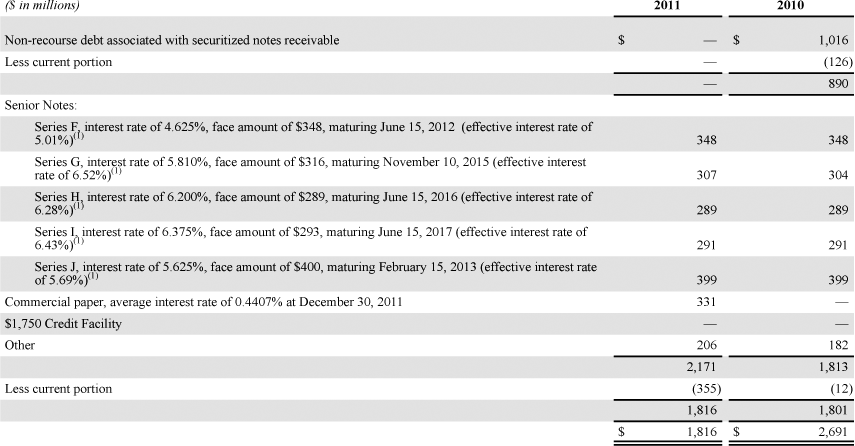MD&A
Quantitative and Qualitative Disclosures About Market Risk
Financial Statements
Notes to Financial Statements
Shareholder Return Performance Graph
Quarterly Financial Data
Selected Historical Financial Data
Non-GAAP Financial Measure Reconciliation
Management’s Reports
Reports of Independent Registered Public Accounting Firm
12. LONG-TERM DEBT
We provide detail on our long-term debt balances in the following table:

(1) Face amount and effective interest rate are as of year-end 2011.
On November 21, 2011, all balances related to non-recourse debt associated with securitized notes receivable were transferred to MVW as part of the spin-off. See Footnote No. 17, “Spin-off” for additional information. The non-recourse debt associated with securitized notes receivable, prior to the spin-off, was secured by the related notes receivable. All of our other long-term debt was, and to the extent currently outstanding is, recourse to us but unsecured. Other debt in the preceding table includes capital leases, among other items.
We are party to a multicurrency revolving credit agreement (the “Credit Facility”) that provides for $1.75 billion of aggregate borrowings to support general corporate needs, including working capital, capital expenditures, and letters of credit. The Credit Facility expires on June 23, 2016. The availability of the Credit Facility also supports our commercial paper program. Borrowings under the Credit Facility bear interest at LIBOR (the London Interbank Offered Rate) plus a spread, based on our public debt rating. We also pay quarterly fees on the Credit Facility at a rate also based on our public debt rating. While any outstanding commercial paper borrowings and/or borrowings under our Credit Facility generally have short-term maturities, we classify the outstanding borrowings as long-term based on our ability and intent to refinance the outstanding borrowings on a long-term basis.
Each of our securitized notes receivable pools (all of which we transferred to MVW on November 21, 2011 in conjunction with the spin-off of our timeshare operations and timeshare development business) contained various triggers relating to the performance of the underlying notes receivable. If a pool of securitized notes receivable failed to perform within the pool’s established parameters (default or delinquency thresholds by deal) transaction provisions effectively redirected the monthly excess spread we typically received from that pool (related to the interests we retained), to accelerate the principal payments to investors based on the subordination of the different tranches until the performance trigger was cured. As a result of performance triggers, a total of $2 million, $6 million, and $17 million in cash of excess spread was used to pay down debt during 2011, 2010, and 2009, respectively.
We show future principal payments (net of unamortized discounts) and unamortized discounts for our debt in the following tables:
Debt Principal Payments (net of unamortized discounts)

Unamortized Debt Discounts

In 2009, we repurchased $122 million principal amount of our Senior Notes in the open market, across multiple series. We recorded a gain of $21 million for the debt extinguishment representing the difference between the acquired debt’s purchase price of $98 million and its carrying amount of $119 million. The weighted average interest rate on the senior debt that was paid down in 2009 was 6.8 percent.
We did not repurchase any of our Senior Notes in 2011 or 2010.
We paid cash for interest, net of amounts capitalized, of $130 million in 2011, $148 million in 2010, and $96 million in 2009.
